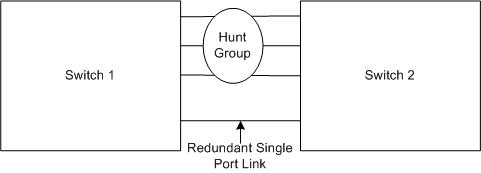Hunt Group Configuration Considerations
Consider the following before creating hunt groups:
- Hunt group end to end physical connections must be configured with the hunt group ports connected to hunt group ports.
- All ports of the hunt group must be of the same bandwidth and all layer 2 or all layer 3 ports (but not a mix)
- Can have a mix of 80-series and 50-series as long as they are the same bandwidth and all layer 2 or all layer 3. (but not a mix)
- A hunt group cannot be distributed between more than two switches.
- You must disable or disconnect the ports in a hunt group until both ends of the link are configured.
- All ports in the hunt group take on the configuration of the base port
- Both sides of the hunt group have the same configuration
- Any change to a port in the hunt group will be reflected on all ports.
- When removing a port from a hunt group with the Web Agent, it must be removed before its VLAN assignment is changed.
- If 48-port mode is enabled on the switch, only the first thirteen hunt groups are retained and all others are discarded. The ports associated with the discarded hunts groups lose their hunt group bindings, but retain their VLAN bindings and are still active as VLAN bridges. Spanning tree may or may not, due to the topology or spanning tree settings on those ports, forward traffic over unwanted trunks.
- If the switches participating in a hunt group are running Spanning Tree, Avaya recommends that you run RSTP. RSTP makes it possible for a second link in the hunt group to rapidly transition to forwarding state if the base port fails. For more information on RSTP, see Chapter 7:�Configuring Rapid Spanning Tree.
- If all links in a hunt group fail, and the traffic fails over to a redundant single-port link, a loss of traffic occurs until the routing protocols that are running recalculate their routes. Figure�50 shows this configuration.
Figure�50:�Hunt Group and Redundant Single-Port Link
